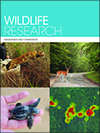
Wildlife Research
Volume 50 Number 3 2023
Special IssuePredator–prey interactions

We evaluated the influence of apex predators on the drivers of mesopredator space use and detection in South Africa. Apex predators both positively and negatively affected the detection of black-backed jackals, indicating that these mesopredators show behavioural flexibility at the individual site level. These findings suggest that sympatric predator behaviours should be based on site-specific behaviours instead of general patterns. Photograph by Rebecca Welch.
WR22042Nest remains are insufficient to identify predators of waterfowl nests
 , Kyle J. Kuechle, Mason L. Sieges, Sam Krohn, Cailey D. Isaacson, John Palarski, Nick Conrad, Allicyn Nelson, Boyan Liu, Thomas K. Buhl
, Kyle J. Kuechle, Mason L. Sieges, Sam Krohn, Cailey D. Isaacson, John Palarski, Nick Conrad, Allicyn Nelson, Boyan Liu, Thomas K. Buhl  and Susan N. Ellis-Felege
and Susan N. Ellis-Felege

Accurately determining nest fate and the identity of nest predators can help scientists make better management recommendations. This study determined that although a visual inspection of nest remains was sufficient to determine the nest fate (e.g., hatched, abandoned, depredated) of precocial ground-nesting waterfowl, in most cases it failed to identify nest predators. We recommend the continued use of alternative methods, such as nest cameras, for scientists hoping to identify nest predators in the field. Photograph by Dr. Susan Ellis-Felege.
WR22042 Abstract | WR22042 Full Text | WR22042PDF (1.4 MB) Open Access Article

Camera trapping is a popular method for studying wildlife communities and scent lures are often used to improve detection of carnivores without considering the influence on other species. This study evaluated how a scent lure influenced detection of four species across foraging guilds and demonstrated disparate effects on species. We recommend that researchers avoid using scent lures or account for potential variation in their influence on detection for each species when assessing wildlife communities with cameras. Photograph by Marlin M. Dart.
WR21184Fox and cat responses to fox baiting intensity, rainfall and prey abundance in the Upper Warren, Western Australia
 , Adrian F. Wayne
, Adrian F. Wayne  , Ayesha I. T. Tulloch
, Ayesha I. T. Tulloch  , Euan G. Ritchie
, Euan G. Ritchie  , Marika A. Maxwell and Tim S. Doherty
, Marika A. Maxwell and Tim S. Doherty 

Invasive predators are major drivers of global biodiversity loss. Red foxes (Vulpes vulpes) and feral cats (Felis catus) have contributed to the decline and extinction of many native species in Australia. We aimed to understand what influences the association between fox baiting intensity, red fox activity and feral cat activity. Although the association between fox baiting and fox activity is unclear, our results indicate that fox baiting may be most effective at decoupling the positive association between fox activity and prey activity. Our results also suggest a positive association between fox baiting intensity and feral cat activity, meaning integrated fox and cat management is required in the Upper Warren. Image created by the authors.
WR21184 Abstract | WR21184 Full Text | WR21184PDF (3.1 MB) | WR21184Supplementary Material (709 KB) Open Access Article

The behaviours that dingoes use to capture and kill their prey are highly dynamic and can be challenging to observe directly without disturbance. This study reports a series of direct observations of wild hunting behaviour filmed using cameras attached to either a helicopter or drone. This project contributes to our knowledge of dingo ecology and also acts as a case study highlighting the utility of drones for directly observing dynamic behaviours in the wild. Images by Daniel Hunter and Edward Saltau.
WR22033 Abstract | WR22033 Full Text | WR22033PDF (1.6 MB) | WR22033Supplementary Material (328 KB) Open Access Article

DNA metabarcoding and morphological examination are major approaches for dietary studies using faeces. We evaluated the performance of these approaches in an endangered ground-dwelling gecko, Goniurosaurus kuroiwae, and showed that DNA metabarcoding detected more prey types than morphological examination (21 vs 17); but the latter was not a complete subset of the former. To describe the diet of insectivores, we recommend using both methods complementarily. Photograph by Takaki Kurita.



